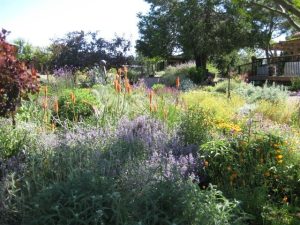Lovely Lavender
Now that I’ve learned (sometimes hard) lessons about gardening in the Sierra foothills, I’ve come to a simple conclusion. If a plant tolerates my soil and a little drought, doesn’t scream for constant attention, and almost always isn’t on our deer’s menu, it’s a keeper! Lavender fits all of those descriptions.
Reasons to grow lavender:
- Very drought tolerant – native to sunny Mediterranean regions.
- Grows well on rocky areas, gritty, or poor soils. No need to fertilize.
- Blooms have a luscious scent – easily be dried and used in many ways.
- Attractive foliage.
- Attracts butterflies, bees, and other beneficial insects. Deer don’t seem to like it one bit!
- Plants are quite resilient (not all plants are hardy at all elevations).
Planting tips:
- Plant in full sun.
- Prep the soil so it is loose and provides good drainage.
- Plant a little higher than the soil line.
- Keep the soil pH alkaline (opposite of acidic)
Pruning:
- Start pruning lavender while it is young. Dead-heading after flowering improves appearance. Take off dying limbs whenever they occur.
- Most lavenders need to be sheered hard annually to keep their shape and to prevent them from getting too woody. I’ve seen people use line trimmers, a technique that works well as long as you don’t prune all the way down to bare wood.
- If you live at 2,500′ and below, you can prune in late fall. I prune again lightly in the spring or when the bloom cycles are over.
- If you live in harsh freezing weather, wait until early spring to prune. Don’t prune more than 1/3 of the mature plant and prune again when they are completely finished with their bloom cycles.
In the genus ‘Lavandula’, there are about 39 different species of lavender. Here is a partial list of the most common, many of which grow well here. Experiment with your own environment:
- The earliest blooming species are Spanish, Yellow, Sweet, Woolly and Allardii. A favorite of many Master Gardeners is Spanish lavender – Lavandula stoechas ‘Otto Quast’.
- Mid to late spring bloomers are English – Lavandula angustifolia. Common varieties are Munstead, Hidcote, Dwarf blue, Lady and a true dwarf called Thumbelina. My favorite is Lodden Blue for its compact size and vivid color.
- The next bloom cycle is the Lavandins – Lavandula x intermedia – (the x means it is a cross with two plants). Some favorites of these English hybrids are Provence, Fred Boutin, Grappenhall, and Gros Blue. Grosso is a favorite because of its deep purple color and beautiful rounded shape.
- Another summer bloomer is Lavandula dentata -French Lavender. ‘Goodwin Creek Grey’, a hybrid of French lavender, has an extensive blooming season in very mild climates, although some find it tender in higher elevations.
- A long season bloomer (for my lower elevation) is Lavandula pinnata – called fern leaf, lace, or jagged lavender. It is very tender but worth growing as an annual.
Kathy Nunes is a Master Gardener who has been known to swipe handfuls of lavender blooms just to crush them to get the full scent.

